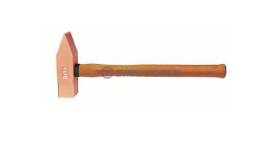Explosion-proof copper hammer is the main type of china non-sparking tool used in various flammable and explosive places. Explosion-proof copper hammer generally consists of a hammerhead and a hammer handle. The length of the hammer handle of explosion-proof copper hammers is generally fixed, and the length of the hammer handle cannot be adjusted according to different use conditions. Storage, transportation, and other large-scale flammable and explosive places hit workpieces, install machines, and rock, gravel and other places with high impact forces when opening mountains and roads. Explosion-proof copper hammer is one of the hammers commonly used in explosion-proof tools. Explosion-proof tools are available in aluminium bronze and beryllium bronze.

China hand tools manufacturer introduces the operation guide of explosion-proof tools
1. The selection of explosion-proof copper hammer is very important when working. For example, the weight of the copper hammer should be compatible with the workpiece, material and function. It is not suitable for being too heavy or too light. When the mass of the copper hammer is doubled, the energy is doubled, and when the speed is doubled, the energy is doubled. When using a copper hammer, use a copper hammer correctly and master the hitting speed.
2. When using an explosion-proof hand hammer, pay attention to the firm connection between the hammerhead and the hammer handle. If there is a looseness, the wedge should be tightened immediately or the hammer handle should be replaced again. The length of the handle of the hammer is moderate. The length of the forearm is equal to the length of the hand hammer; the hand swing method can be used when a small impact force is required, and the arms swing method should be used when a strong impact force is required; pay attention to the hammerhead when using the arm swing It is strictly forbidden to be contaminated by grease with the handle of the hand arc to prevent it from being thrown out when hit. An explosion-proof claw hammer is used for striking, hammering, and pulling various nails, but the claw hammer is not a problem when hammering large workpieces, and when nailing, the hammerhead should be flat against the nail cap to make the nail vertical When entering the wood, pay attention to the flatness of the hammering surface to prevent the nails from flying out or the hammer from slipping and hurting people. When lifting nails, it is advisable to place wooden blocks in the horns of the sheep to enhance the workability. Do not use the claw hammer as a crowbar.
3. Pay attention to the following points when using explosion-proof sledgehammer:
The hammerhead is firmly connected to the handle. Any looseness of the hammerhead and the handle, and the split and crack of the handle cannot be used. The wedge of the hammerhead and the hammer handle in the mounting hole is preferably a metal wedge. The length of the wedge should not be greater than 2/3 of the depth of the mounting hole. For elasticity when hitting, the middle top of the handle is slightly narrower than the end. When using a sledgehammer, pay attention to the front, back, left and right, and up and down. It is strictly forbidden to stand in the range of the sledgehammer, and it is forbidden to strike and beat each other with the sledgehammer. The hammerhead is not allowed to be quenched, cracks and burrs are not allowed, and flashing curls should be repaired in time.
没有评论:
发表评论